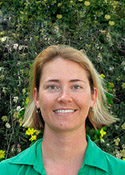
Colden Baxter
CERE Director
Office: Life Sciences 310
Professor of Ecology of Freshwater Organisms
Ecosystems & Social-Ecological Systems
Research conducted by Dr. Baxter and his group of students and collaborators focuses on rivers and streams, but more generally on the ecological linkages between water and land. The group’s studies are aimed at improving understanding of the basic nature of reciprocal connections between streams, floodplains, and riparian forests, the consequences of their disruption by human activities, but also contributing to better-informed conservation and stewardship. Recently, they have begun investigating watersheds as social-ecological systems, asking, for instance, how human perceptions and behaviors influence, but are also influenced by, rivers.

Sarah Godsey
Board Member
Office: Phys. Sci. Bldg. 3, Room 231
Associate Professor of Geosciences
Our group at Idaho State University focuses on hydrology in mountain and polar regions. We're interested in how climate and land use changes may affect water resources in these areas.
I am currently studying hillslope contributions to fluvial carbon fluxes and patterns of water quality in drinking water and risk perceptions associated with water pollution in mountainous watersheds throughout Idaho. We're also currently wrapping up a collaborative project to understand coupled hydrology and biogeochemistry of water tracks in Arctic Alaska with a great team from the University of Alaska Fairbanks.
.jpg)
Josh Grinath
Board Member
Office: Life Sciences 420 & 421
Assistant Professor
Community and Global Change Ecology
My research addresses broad questions about the processes that determine ecological community structure and ecosystem functioning. Specifically, I am interested in understanding how drivers of global change such as atmospheric pollution, climate change and species invasions, restructure communities and impact ecological dynamics from plants to predators. My work primarily occurs in grassland ecosystems that include plants and animals of conservation concern and that provide vital ecosystem services to humans. Using field experiments and modeling, I study systems that contain multiple types of species interactions, such as predation, mutualism, and ecosystem engineering. While many ecologists study ecological networks composed of single types of species interactions, for example food webs or mutualistic webs, most ecological systems are composed of multiple interaction types that must be considered together to fully understand the consequences of global change. Overall, my goal is to conduct research that is relevant to managing current and future environmental challenges and that can inform conservation efforts.
One of my primary research goals has been to understand how atmospheric nitrogen (N) deposition and the cascading effects of predators restructure a plant-arthropod community in a Colorado sagebrush steppe ecosystem. Through field experiments and network analysis, I discovered that ant-eating black bears indirectly benefit plants by suppressing an ant-herbivore mutualism, which should be considered in the management of bears. However, I also found that simulated low-level N deposition weakens this cascade of effects, which suggests that current widespread rates of N deposition have altered resource versus consumer control of ecological structure in other ecosystems as well. I have maintained this N manipulation for twelve years now and am revisiting this experiment to assess the long-term repercussions of low-level N deposition. This project provides a unique opportunity to not only assess the effects of chronic N deposition on plants, like most previous studies, but on animals and plant-animal interactions.
I have also conducted research on how an annual grassland community in California is structured by precipitation and a dominant, burrowing herbivore – the federally endangered giant kangaroo rat. I led studies on the ecosystem engineering effects of these rodents on soil properties (soil moisture and N dynamics) and plant-arthropod communities. In addition, I have used a combination of field experiments and herbarium records to study ‘cedar glade’ grassland responses to climate change, invasive insects, and restoration efforts in Tennessee.
My current research is focused on understanding how the combination of changes in N deposition and climate impact plant-animal communities and ecosystem functioning, particularly in sagebrush steppe ecosystems of the Intermountain West. Plant growth is commonly limited by both N and water availability and respond synergistically to simultaneous changes in these resources. However, animal responses to these dynamics are poorly understood, as are the repercussions for ecosystem functioning.
Please see my personal website (jbgrinath.wordpress.com) for further details.

Katrina Running
Board Member
Office: Kegel Liberal Arts 362
Director of Graduate Studies/Associate Professor of Sociology
My research examines how farmers are adapting to agricultural water restrictions in Idaho, international variation in public opinion about climate change, and the public’s perception of ecosystem services in Idaho, frequently through the lens of environmental justice. Much of this work is conducted as part of interdisciplinary research teams as I think understanding complex socio-ecological systems requires multiple perspectives, approaches, and disciplines.

Jennifer Cornell
Board Member
jennifer.cornell@deq.idaho.gov
Surface Water Quality Manager, Idaho Department of Environmental Quality, Southeast Region
I'm a stream ecologist with a background in Water Resource Management, including extensive experience in the field and lab. I also have expertise in plant surveys, biological inventory/data management and restoration and general project management skills. In addition to my work in conservation and environmental protection, I am interested in science and education, as well as teaching. I do a lot of outreach through my position to increase the public's knowledgeable about our natural world through engaging, informative and accurate Environmental Awareness projects that will allow them to enjoy the beauty of nature!
